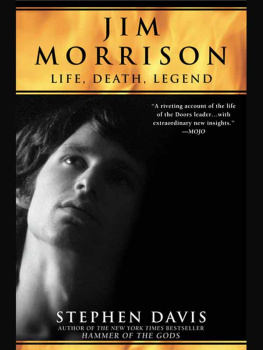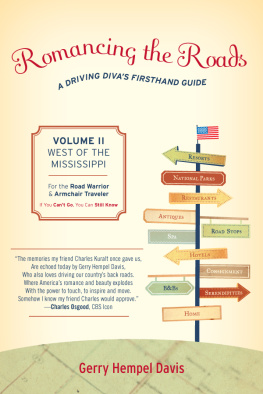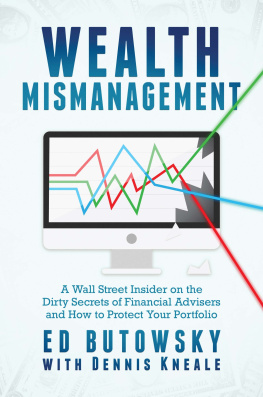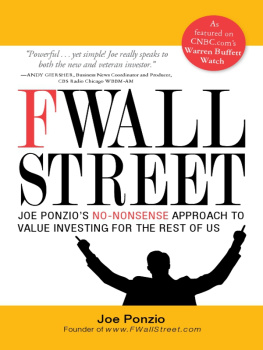Its all a crapshoot.
Fred Craig
ON SEPTEMBER 7, 2001, an important client called my office and instructed me to liquidate his account. He didnt have a particular reason for doing so; he just felt unsettled. Having been trained in the Wall Street way, I encouraged him not to sell any of the quality investments in his account and rehashed all the reasons Id been taught to never sell equity investments.
Despite my best efforts to dissuade this client from making a rash move prompted by little more than an uneasy feeling, he was resolute. I followed his instructions.
Id gone to work as a stockbroker for Dean Witter in 1992. When I came back from training at the company headquarters in the World Trade Center in New York, I was armed and dangerous. This client was a contractor, and one of the most highly regarded custom homebuilders in Mississippi. He was also my stepfather and a man I admired greatly. We had a great relationship, and he had a sharp wit. The first thing my stepfather, Fred, said to me upon my arrival in Mississippi was, Its all a crapshoot. He said that to me over and over again, and I hated it.
Investing in the market was a crapshoot as far as Fred was concerned. He viewed Wall Street as the house and the public as the players. I couldnt stand it, but that didnt stop him from saying it. Its just a crapshoot, he would say, whether we were making money or losing moneyit didnt matter which.
The reason I hated hearing it was that deep down I feared he was right. The way Id been trained to buy and hold investments for clients with little regard for what was going on in the market had never sat well with me, but I didnt know any other way to do it. My entire career up to that point had been in a bull market, so when they said buy the dips, it had always worked.
Well, it worked until it stopped working. The long-term bull market that had been in place since 1982 ended in mid-2000, but even in the wake of the 9/11 attacks, Wall Streets advice was to stay the course. As the market continued to decline, I became increasingly uncomfortable acting as little more than a cheerleader for my clients and the market. If the market was really just a crapshoot, we were on one heck of a bad run, and I wanted to change tables.
Even if Fred couldnt put his finger on why he felt the way he did, one thing was for sure: he was out of the market two trading days before 9/11.
So I began my real education about markets, risk, and opportunity. If the market was a crapshoot, then I wanted to improve my odds. If there were people who knew a better way of doing things than Wall Streets Buy, Hold, and Hope method, I was sure going to find them.
The investment community seems to be split into two distinct groups.
The Buy-and-Hold Investors
The largest group is the one that believes successful investing is predicated on investing in a diverse set of investments and holding them for a very long time. This group emphasizes financial planning, asset allocation, and diversification.
Given sufficient time, the stock market has always gone to new highs, and therefore owning the market long-term is the best course of actionat least according to this first group. Rather than focus on which investments to make and how best to time those investments, they focus on establishing an asset allocation based on the investors age, time frame, and tolerance for risk. There is an emphasis on client goals and a reliance on the markets (the investment allocation) to achieve those goals over the long term.
The Tactical Investors
The second and much smaller group tends to focus on making tactical investments given current market conditions, the availability of favorable investment opportunities, and risk management. Tactical investors generally arent content with just taking whatever return the market provides. They favor investment systemstrend-following systems and counter-trend systems, to name just two.
While the market has always ultimately made higher highs, this group would point out that there have been long periods during which the market has produced little or even negative returns. Tactical investors are interested in generating positive returns even when the markets are in decline.
These Two Groups Have Been Largely Incompatible
Buy-and-hold investors simply dont believe that performance can be improved by security selection or trend analysis. Planning and long-term investing is the key to success, they would say.
Tactical investors cant imagine why buy-and-hold investors would continue to own investments that decline 50 percent and more. They believe there is no riskier proposition than investing in the market as a buy-and-hold investor with little or no sell discipline.
What Am I?
In the early part of my twenty-plus-year investment career, having been trained by Wall Street firms, I found myself in the buy-and-hold camp. But as the markets began to unravel in the early 2000s, I became increasingly uncomfortable with the methods Id been taught and had advocated. I had a confidence crisis.
The eighteen months from March 7, 2000, through September 11, 2001, were a period of great learning for me. As the S&P 500 was peaking in the first few weeks of March 2000, I was focused on the birth of my first child and was paying little attention to the market or my personal investments. By the time I re-engaged, my investment account was down several hundred thousand dollars.
Because I had been weaned on the buy-and-hold mentality, I stayed the course. Conventional wisdom told me to hold on, so thats exactly what I did.
Then something extraordinary happened. Within a matter of months, the company I worked for got bought out. As a result of the buyout, I had more than $1 million. Keep in mind that this was a time when it was difficult to make and protect money in the market, and there I was, thirty years old and sitting on a small fortune. I had lost even more money in my investment account, but within months Id made it all backbecause I was in the right place at the right time. But the sudden windfall had nothing to do with making quality investment decisions or the buy-and-hold motto. If anything, adhering so religiously to this philosophy kicked me when I was already down.
Then, the very next year, the World Trade Centers twin towers fell. In the immediate aftermath of the 9/11 attacks on our country, the stock market closed for four days, re-opening on September 17 th . Those days were long ones for every American as we contemplated the tragic loss of life, wondering if anything would ever be the same again.













